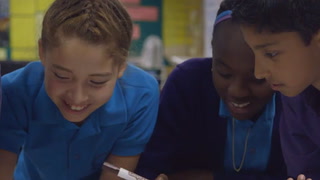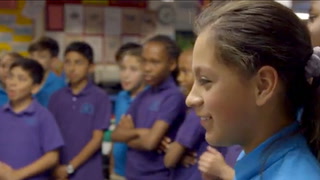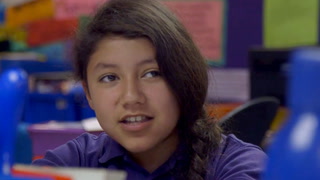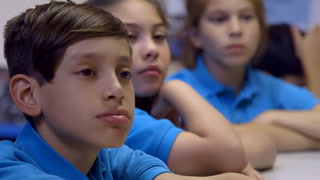Encouraging Student Debate Transcript
ANTOINETTE PIPPEN [sync]
00:00:00 Looking at this work of art, would you say that it is balanced or imbalanced?
ANTOINETTE PIPPEN
00:00:07 The next generation science standards require students to be able to engage in debate. And the debate is not with me. They’re not talking to me. In order to debate with each other, they need to listen to each other.
GIRL IN BLUE
00:00:19 I agree with Marianna because…
ANTOINETTE PIPPEN
00:00:22 And so, how do you as a teacher get them to engage with each other?
00:00:28 [TITLE: Encouraging Student Debate]
[TITLE: A Classroom Strategy]
ANTOINETTE PIPPEN
00:00:32 Getting students to listen and be accountable to each other can be a messy process. One of the first things you need to do is get the students looking at, and listening, and talking to each other.
GIRL WITH PONYTAIL
00:00:45 It’s imbalanced because it doesn’t show, like- it only shows, like, for me it only shows, like, n kind of animals.
ANTOINETTE PIPPEN
00:00:52 Naturally, students are going to want to talk to who’s ever looking at them. So, if you as the teacher avert your eyes or look away and take yourself out of the conversation, then they are going to talk to their peers.
00:01:06 And so, if the other students are looking at them, they’re going to start talking to those people looking at them.
00:01:12 [TITLE: CLASSROOM STRATEGY]
[TITLE: Avert your gaze to encourage eye contact between students]
GIRL IN BLUE
00:01:13 But the reason why I think it’s imbalanced also because it has too much, like, animals.
ANISA
It doesn’t look balanced. The snake in the middle doesn’t match.
ANTOINETTE PIPPEN [sync]
So, you’re saying this snake in the middle makes it imbalanced?
ANISA
00:01:28 Yes.
00:01:30 [TITLE: FURTHER VIEWING]
[TITLE: Look in the guide for the complete lesson video]
ANTOINETTE PIPPEN [sync]
00:01:30 So, if we open it up and I actually just saw somebody…
ANTOINETTE PIPPEN
00:01:32 Initially, it’s a lot of repeating, recasting what students say until other students are actually listening to each other.
00:01:41 [TITLE: CLASSROOM STRATEGY]
[TITLE: Repeat students’ statements to stimulate debate]
ANTOINETTE PIPPEN [sync]
00:01:41 There are some, but I think most of the snakes that I…
ANTOINETTE PIPPEN
00:01:45 Early on in the conversation you might hear me more because I’m going to be recasting or restating what students are- are saying.
ANTOINETTE PIPPEN [sync]
00:01:52 Lisa’s saying this is imbalanced. The snake in the middle, in particular, makes it imbalanced to her. Does anyone want to add on or maybe give another point of view?
ANTOINETTE PIPPEN
00:02:02 They tend to want the teacher to say, “Yes, that’s right,” or “No, that’s wrong.” But definitely do not say, “Right. Wrong.” You might restate or paraphrase what someone has said, but you do not agree or disagree with anyone.
ANTOINETTE PIPPEN [sync]
00:02:17 Does anyone think it is balanced?
MARIANA
00:02:19 I disagree with Anisa, Josue, and Elizabeth because the crayfish, they’re both on different sides. And the leaves are spreaded out everywhere.
ANTOINETTE PIPPEN
00:02:33 Once you establish that culture and cultivate that comfort, they debate with one another and question one another. And that takes some bravery and that takes some time and that takes some challenge for them to really engage with each other.
ANISA
00:02:46 Mariana, the question is why do you pick balanced?
MARIANA
00:02:53 Well, not all the components are on one side or the other. And if they’re all separated, it’s much more balanced.
ANTOINETTE PIPPEN
00:03:02 So, maybe it’s also cultivating a joy of arguing to explore concepts through debate and that that itself is something fun.
00:03:16 ***FILE END***













8 Comments
Kathleen Wilson Nov 20, 2020 1:40pm
I tend to want other students to do the restating, recasting, or paraphrasing what each other says.
Ayda Patricia Segura Jul 3, 2016 7:31pm
toni oliviero Jan 4, 2016 1:31pm
susan arkelian Jul 31, 2015 6:23pm
yvette Fagundes Feb 3, 2015 2:51pm